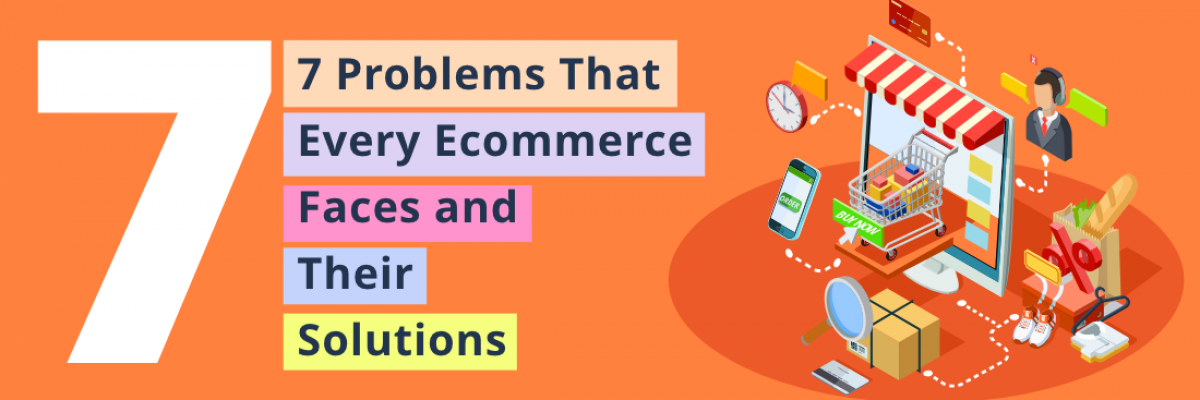Tackle the 7 Ecommerce Problems With Platform-Based Solution
Every ecommerce businesses face some or other kind of obstacles. So, how will you make a successful debut in this ecommerce world? You have to test the waters before investing in the business just to make sure you are avoiding the common mistakes.
If you want to own an ecommerce platform to start building your online store, it is necessary that you choose the right platform that perfectly fits your current and future requirements. To be on the safer side, consider choosing an ecommerce platform that allows you to overcome the following 7 common challenges.
7 Ecommerce Problems and Their Solutions
Problem 1: Your site experiences slow page loading issues
Solution: Make your site’s web pages to load quickly as it impacts customer experience and findability. According to reports from Akamai, an extra 100-millisecond delay in page load time of a website reduces the site's conversion rate by 7%. Further, if shoppers are waiting for two seconds, your site's bounce rate will increase by more than 100%.
Even, Google and other search engines don't prefer slow websites either and are considered to use page load times as a ranking factor for SERP. Therefore, choose a high-performing next-gen ecommerce platform to tackle this problem. For example, Purchase Commerce’s platform is blazing fast and is able to handle concurrent users even during high traffic periods. Also, this is based on the technology your platform is built upon and where you are hosting your website.
Problem 2: Your ecommerce app doesn't integrate the third-party apps
Solution: Often ecommerce platform users face subpar experience due to disparate systems. Hence, making a seamless connection between different systems is an integral part of any digital transformation. Using integration capabilities like API’s, many disparate systems can be combined to create a best-in-class ecosystem to better serve any specific function.
All the systems used in a platform has a wide range of architecture, usage and deployment. But most often these are built on outdated technology and ultimately leads to stagnation down the road. That being the case, it is better to opt for advanced technology platforms that are flexible enough to connect different components because of their loosely coupled architecture.
Problem 3: Your site is not scalable, flexible and robust
Solution: Scalability is a major issue in ecommerce business and is mostly ignored by site owners while they opt for a specific platform. But later they realize this factor and understand the hidden challenges behind it. In order to tackle this issue, you can consider flexible technologies that can help you respond to market demands quicker than your competitors.
Spikes in site visitors' traffic and online orders can bring down a website, overwhelming its server, thereby, causing fatal problems for your retail business. Closely connected to website speed is your website's ability to scale during maximum traffic periods. On the grounds of this, analyze your business requirements to ensure that the technology you invest in should be agile, flexible, scalable, and robust.
Problem 4: Your ecommerce site is facing security vulnerabilities
Solution: One of the challenges of ecommerce is ensuring security. When shoppers place an order on our ecommerce site, they are putting their trust in your business. They expect you to keep their information safe and secure. To at least some degree, your business has a responsibility to those customers, and when you fail, it can deteriorate your brand’s trust and authority.
For this reason, you need to take the best measures to prevent vulnerabilities. You should check with your ecommerce solution provider whether they have done everything possible to make certain your customer's information is secure. Besides, look into ways to protect your site. To make your site secure, implement SSL connections, and create robust data storage.
Problem 5: Your ecommerce site is not optimized for mobile
Solution: Your ecommerce site must be mobile optimized if you're going to be competitive, and not all enterprise ecommerce solutions are right for mobile. In 2021, 53.9% of all retail e-commerce is expected to be generated via m-commerce, according to Statista. But if your site is slow, it may not show up, especially for search queries from mobile devices. Thus, you might lose a large chunk of customers.
One of the ways to address this issue is to adopt a mobile-first approach that makes your site responsive and mobile-friendly. Another way is to leverage the Progressive Web App (PWA) platform as they are easy-t0-use for your mobile users just like a native app. PWAs are the go-to option for you if you want to enhance mobile conversions.
Problem 6: Your ecommerce app doesn't support effective product uploading
Solution: Product information imports, updates, and maintenance are, perhaps, some of the most time-consuming aspects of online retailing. In an offline store, a customer can see a physical product, handle it, and read its packaging. But for an online store, the retailer should offer at least one product image, a prose product description, and a list of product specifications.
Product information maintenance can make your enterprise ecommerce business hidden unless you can add product information programmatically. For this, you have to choose an advanced ecommerce platform with a robust API. This API should allow you to send product information from your enterprise resource planning (ERP) software directly to your Online Store without requiring any data entry.
Problem 7: Your ecommerce website is not SEO-friendly
Solution: Following the best SEO practices is critical to ensure success for your online retail business. Customers visit your site from different traffic sources like Facebook, Instagram, email marketing, search, and more. But the fact is that 36% of product searches actually start and come from the search.
In order to make your ecommerce site SEO-ready, it might seem like a huge task if you already have a website populated with tons of product. So, prioritize product pages that you want people to focus and optimize for those products first. Keywords still matter. Therefore, use keywords in your product headline, description, meta description, image alternate attributes, and sub-headlines.
Pepper latent semantic index (LSI) keywords throughout the description. These are relevant keywords that help search engines understand your product page in context. Furthermore, check whether your platform SEO-friendly which enables your products and its description get discovered online when someone searches for them.
Platform-based Ecommerce Solution
When you choose an advanced ecommerce platform like Purchase Commerce to build your ecommerce store, it solves all the above issues with its in-built functionalities. For example, Purchase Commerce is built on top of cutting edge technologies like Angular, NodeJS, MariaDB and MongoDB, which brings in faster page loading experience for your customers and at the same time, your site will be scalable, flexible and robust.









